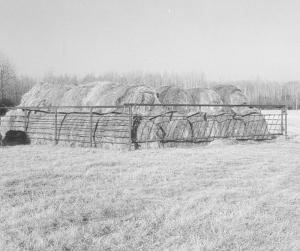2002 - Volume #26, Issue #2, Page #07
[ Sample Stories From This Issue | List of All Stories In This Issue | Print this story
| Read this issue]
Hay Storage Unit Doubles As A Self-Feeder
 |
"I looked at a lot of systems, but couldn't find anything that I could make work. I tried bale feeders and also put wood posts with electric fence wires around stacks. Nothing I could find worked to my satisfaction," he says.
"I chewed on the problem for four years," he says. "I wanted a self-feeder that was portable, that didn't require any power, that would last a long time, and that would hold enough feed that I wouldn't have to refill it every day."
Nieslony came up with what he calls the "Sweet Oly Feeder," a large self-feeder that he puts right on pasture.
Using salvaged 2-7/8 in. drill stem pipe and sucker rod, Nieslony built three panels 30 ft. long and 6 ft. high. He used the pipe for the frame and uprights in the panels and then welded sucker rod horizontally 8 in. apart from top to bottom.
The panels make up three sides of a square. For the fourth side, he built a panel that measures one foot shorter (29 ft.) in length and about a foot shorter in height. The top bar of this panel, however, is 31 ft. long and rests on top of the sides of the feeder.
Rather than horizontal bars like the sides and back, the front panel has slanted slots made by welding 3/4-in. sucker rods 14 in. apart, all the way across it at a 60-degree angle. Depending on the size of the cow, 10 to 12 can eat at a time. The cattle push into the sliding front panel back toward the hay as they feed.
Nieslony attaches two chains to each side of the front panel. They fasten to the front posts of the side panels and let him control how far the cattle can push the feed gate. "I make sure they clean up any hay on the ground before I loosen up the chains," he says.
To keep cattle from reaching in from the sides and backs of the racks, he cut old tarps in 6 ft. lengths and hangs these over the rails before filling them with hay.
Nieslony's storage rack/feeders will hold up to fifty 1,500-lb. bales inside the 30-ft. square, when stacked two high.
"You can store hay anywhere and the cows can't get at it," he says. "If I have a weedy field and don't want to spread my weed seed, I can store the hay in that field and confine the cows there until the hay is eaten.
"If I want to put more than 50 bales in the stack, I can put two sidewalls together on each side and make it 60 by 30 ft.," he points out.
Besides working with big round bales, Nieslony says his feeder is also ideal for feeding from those big Hesston hay stacks. "I have an old 8 by 14 Hesston stacker and can put nine loaves together inside one feeder," he says.
Nieslony liked the way his big self-feeder worked so well that he's built four more of them. "The pipe and sucker rod for each panel costs me about $150. It takes about a day of welding to make one side panel."
He can make plans available for a fee if there's interest.
Contact: FARM SHOW Followup, Olaf Nieslony, Box 4633, Barrhead, Alberta, Canada T7N 1A5 (ph 780 584-2154).

Click here to download page story appeared in.

Click here to read entire issue
To read the rest of this story, download this issue below or click here to register with your account number.




